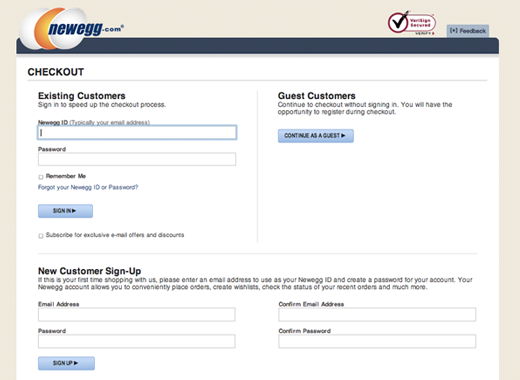
It can take a lot of time to move a customer through the ecommerce sales cycle. You need to attract a potential buyer. You need offer the right products. And, you need them to actually make the purchase. Even within this grossly simplified model, the sales cycle has several touchpoints. Which makes it all the more frustrating when a potential customer drops their transaction at the last minute.
This is what is known as cart abandonment, the proverbial fly in the ointment for ecommerce vendors. To help you alleviate this pain, here are seven tips for reducing cart abandonment.
Explain the Costs Upfront
According to research by the Baymard Institute, 60 percent of cart abandonment cases stem from extra costs, which include shipping fees, taxes and the like. This is commonly known as “sticker shock,” in which a potential buyer is so surprised by the total price they abandon the order. Your ecommerce site may be doing this to shoppers without you realizing it.
While you can’t waive taxes or some fees, you can do more to prevent sticker shock from driving away your customers. How? By simply being more upfront with your costs. One way to do this is to include a sidebar that estimates the cost of shipping via the shopper’s IP address location. Similarly, you can ask purchasers to enter their ZIP codes to get a rough estimate on taxes and shipping costs. Adding fine print reading; “does not include tax, shipping costs, handling fees and etc.” below the price of each item helps prepare buyers to expect the total price to be higher as well.
Allow for Free Shipping & Faster Deliveries

The Guide to Ecommerce Tax Deductions: 19 Business Expenses You Can Write Off
Another common reason consumers abandon orders is the lack of shipping options. Research shows today’s shoppers are demanding fast and free shipping; especially since so many consumers have become spoiled by Amazon Prime. If your shipping fees are higher than your nearest competitors, some shoppers may jump ship at the last second.
Unfortunately, many SMBs cannot afford the same shipping guarantees as an ecommerce giant. Then again, some smaller brands have had great success allowing for selective free shipping. Examples include offering it for orders over $70 or offering free shipping to the most loyal customers.
Another idea is to offer a wide range of shipping options. Here’s an example: Let’s say a shopper is looking to buy Christmas gifts for her friends and family. It’s only October, but she likes to get a head start on the holidays. She makes several purchases from your website and notices you offer a “no rush” shipping option that delivers for free. Now she feels like she is being rewarded for her foresight and is more likely to buy from you in the future.
In contrast, her husband is a last-minute shopper. He is still looking for Christmas gifts on December 21st. He’s not too picky on what he buys. He just wants to be sure the gift is under the tree by December 25th. If you offer rush shipping, even at a costly rate, you are likely to convert this customer over a competitor with no shipping options.
As you can see, a wide range of shipping options may just be as effective as offering free shipping.
Edit Your Returns Policy

The Ticking Time Bomb Of E-commerce Returns
Speaking of options, review your return policies. Baymard finds 11 percent of cart abandonment stems from unsatisfactory returns policies.
Take a moment to understand the mindset of your online shoppers. They can’t see, touch or even try on your merchandise without completing their purchases. This is incredibly difficult for consumers, especially if they are shopping for shoes and apparel. If you don’t offer a return policy, these shoppers are bound to find someone who will.
Even if you can’t afford to waive return shipping fees or fully refund their orders, you should at least offer store credits. Be careful you don’t go overboard though. It is still recommended that you enact some stipulations regarding returns; like only accepting returns within a certain time window or not accepting returns of sale items.
Allow for Guest Accounts & Purchases
As you can see so far, customers like options. They hate to be forced into anything. Which might explain why 37 percent of shoppers say the reason they quit their cart was because the site wanted them to create an account.
Instead of requiring a user to create an account, or sign into an account they no longer remember, allow shoppers to “checkout as a guest.” Popular ecommerce website builders like Shopify empower vendors to set up their checkout processes according to their preferences.
Which leads us into our next tip…
Simplify the Checkout Process & Remove Distractions

Why Most Online Shoppers Don’t Make it Past the First Step of Checkout
If you want shoppers to complete their orders, you need to make it easy for them to do so. Take a moment to review your checkout process. How many pages does the user need to clickthrough to complete their order? Is there a cart page, a payment page, a shipping page, a reviews page and a confirmation page?
That’s five pages, requiring five separate load times.
Do yourself a favor and make the path to checkout as straightforward as possible. Remove any ads or site redirects; and ensure that orders can be completed in one to three pages max.
Send Reminders via Email

Abandoned Shopping Cart Emails: Why You Need Them and What They Should Say
Last but not least, you can harness the power of email marketing reminders. Let’s say you have a shopper’s email on file. Maybe the potential buyer left their email address on their order, or maybe they shared it on a subscription list. Whatever the case may be, it can be extremely helpful to send the shopper a reminder there are items waiting in the cart, ready for checkout. Sometimes a gentle nudge is all it takes to turn a dead-in-the-water order into a successful sale.
This guide will assist you in your efforts toward reducing abandonment. There are additional sales to be made there and your customers will be grateful you reminded them.




